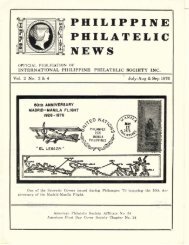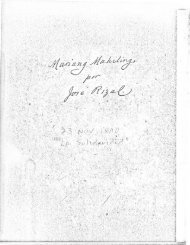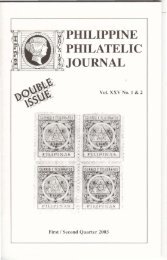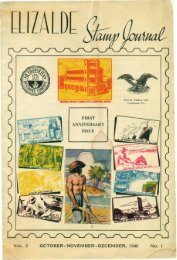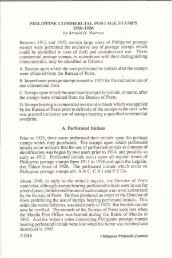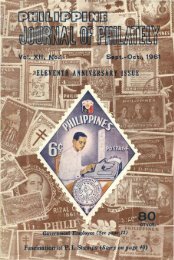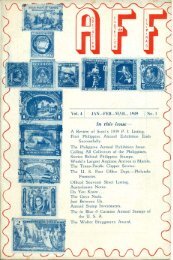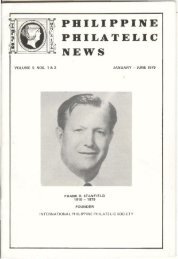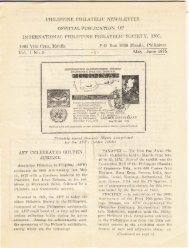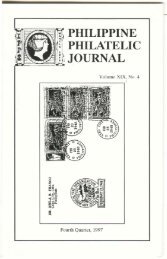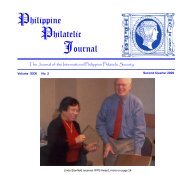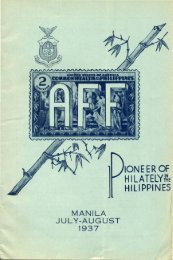April-December 1977, Vol. 3, No.s 2-4 - International Philippine ...
April-December 1977, Vol. 3, No.s 2-4 - International Philippine ...
April-December 1977, Vol. 3, No.s 2-4 - International Philippine ...
You also want an ePaper? Increase the reach of your titles
YUMPU automatically turns print PDFs into web optimized ePapers that Google loves.
PRE-oCCUPATION CENSOR MARK OF TACLOBAN, LEYTE<br />
By Eugene A. Garrett<br />
To the casual observer, the Japanese Occupation of the <strong>Philippine</strong>s commenced on January 2 1<br />
1942, when<br />
troops of the hnperial Japanese Army occupied the Capital City of Manila. Indeed, the CentraJ Government<br />
of the <strong>Philippine</strong>s was then fumly in Japanese hands and unquestionably the Japanese controlled the Cate<br />
of the entire archipelago after that date. However, it required up to several months for the Japanese to 00·<br />
cupy and secure the majority of the islands other than the main island of Luzon and the Davaa area of<br />
Mindanao. It was not until after the surrender of the FilAmerican troops on Bataan and Corregidor that the<br />
Japanese found it expedient to divert the necessary forces to proceed with the invasion and occupation of<br />
many of the outer islands.<br />
To establish the exact date of the occupation of Leyte, I consulted with Mr. C. M. Nielsen of Salt Lake City.<br />
a learned amatew historian of the <strong>Philippine</strong>s. By happy coincidence, Mr. Nieben was at the time preparing<br />
a study of the occupation of !..eyte for the LEYTE-SAMAR STIJDIES, a publication of the Divine Word<br />
University in Tacloban,l.eyte and was therefore able to provide an instant reply:<br />
"Leyte was not invaded by the Japanese. Col. Cornel, commanding<br />
the 9th Military District comprising Leyte and Samar, surrendered<br />
upon orders of Maj. Gen. W. F. Sharp, then in command of all unsw<br />
.rendered forces in the <strong>Philippine</strong>s. The Japanese occupation force of<br />
from 400 to 500 men landed at Pinunapoon, Leyte, on May 24th,<br />
1942, and proceeded to Tacloban where the rurrender took place<br />
on the 25th or 26th - authorities differ. The landing was not opposed,<br />
and the occupation of Leyte was accomplished relatively peacefully."<br />
FIG. 1<br />
It is therefore apparent that Leyte was in a sort of limbo from the outbreak. of hostilities on <strong>December</strong><br />
8, 1941, until the surrender of May 25 or 26, 1942. Although completely cut off from Manila, the local<br />
branches of both the central and provincial governments continued to function as best they could under<br />
the circumstances. In order to preserve the highest possible degree of order throqghout the Islands, President<br />
Quezon had authorized the emergency payment of six months advance salary to an civil servants,<br />
~ great majority of whom continued to carry out their duties and functions until the inevitable ocupation<br />
by the Japanese. In many areas, the postal serivce continued to function on a local basis, long after<br />
such service had been suspended in Manila.<br />
The foregoing preamble brings us now to the specific subject of this discourse, which started when Mr. R.<br />
Hunter Ashmore, Jr., kindly let me bouow the cover illustrated in Figure 1 for the purpose of studying<br />
• superb example of the very rare Tacloban, l.eyte, censor label., Type IIB2, which is affIXed to the revcne<br />
side (not shown). For the specialist collector, it becomes second nature to peele inside any such commercial<br />
17




